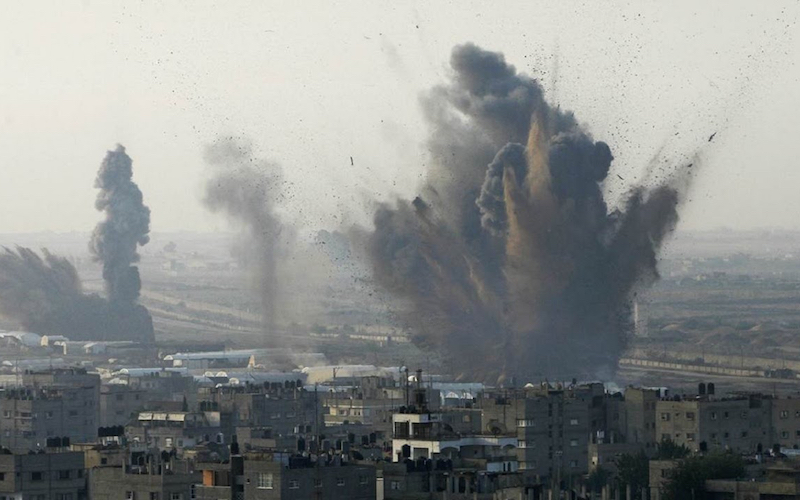
Assad is Still Using Chemical Weapons. What Will It Take to Stop Him?
While the Syrian conflict has been perpetually overshadowed in the headlines by recent events such as the possibility of a Grexit and the Chinese stock market crash, two recent developments regarding Syria’s use of chemical weapons have nearly managed to refocus international attention on Syria. First, on June 17th the House Committee on Foreign Affairs convened a hearing on the Assad regime’s use of chlorine barrel bombs. The Assad regime frequently launches attacks in opposition-controlled areas using barrel bombs filled with conventional explosives. International human rights monitors deplore this tactic because it is intended to kill and terrorize civilians rather than precisely target opposition forces.
Civilians regularly seek shelter from these attacks in basements or bomb shelters; however, chlorine gas, being heavier than air, sinks down into the lowest point of any structure and kills those who have sought shelter underground. The recent Congressional hearing featured direct testimony from doctors affiliated with the Syrian American Medical Society and the White Helmets who had personally treated victims of chlorine gas attacks in Idlib and Hama provinces. Various other organizations, such as the Syrian Observatory for Human Rights, Human Rights Watch, Amnesty International, and the Local Coordination Committee have also reported chlorine attacks by the regime (and not by opposition forces as the regime claims) in multiple villages in Idlib and Nareb provinces.
Second, U.S. intelligence agencies publicly reported this week that they expect another attack by the regime using chemical weapons beyond chlorine bombs. In particular, the Syrian government is suspected of maintaining stocks of sarin and VX gas.
Added to this concern is the worry that the Islamic State is creeping ever closer to these stocks, and might take control of them if the regime collapses.
The initial chemical attack that sparked an international outcry occurred nearly two years ago, in August of 2013, when the Syrian government killed more than 1,400 civilians in the suburbs outside Damascus with sarin gas. After the U.S. threatened to launch airstrikes and international pressure intensified, Assad’s government agreed to accede to the Chemical Weapons Convention and relinquish its chemical weapons stocks, which were be destroyed at sea on the U.S. vessel Cape Ray and at foreign waste disposal facilities. In contrast with U.S. intelligence, officials from the Organisation for the Prohibition of Chemical Weapons, the CWC’s verification mechanism, declared in January that Syria had begun to destroy its remaining chemical weapons sites, with the expectation that all remaining stocks would be destroyed by June 2015. “This is yet another milestone in the path to eliminating chemical weapons stocks in Syria,” OPCW director Ahmet Uzumcu declared.
However, the agreement Syria made when it acceded to the CWC did not regulate chlorine. Although the weaponization of chlorine is banned by law, chlorine itself is not explicitly banned because it is a dual-use chemical essential in the production of medicines and water purification. Ironically, the Assad regime is now accused of denying access to chlorine in areas held by the opposition, which has vastly increased the incidence of diseases like hepatitis A by reducing clean water supplies.
Why would the regime return to the tactics that won it international condemnation and spurred the threat of action by the U.S.? Many analysts believe that Syria has reached a point of total desperation. It is fighting a bewildering assortment of adversaries, including the Al Nusra Front, ISIS, the Southern Front, and opposition fighters being trained by the U.S. in Jordan and Turkey. Recently, ISIS launched attacks on new gas fields in addition to the ones it controls near Palmyra. Al Nusra has driven the regime almost entirely out of Idlib. The Southern Front scored a major victory in the province of Deraa, taking one the regime’s military bases.
The Assad regime may also calculate that any Western military response against the regime would be restrained by a fear of an ISIS takeover in the security vacuum that would follow regime collapse. And of course, Syria can generally rely on Russia to oppose direct action in the Security Council against it. Although Russia voted for a Security Council resolution in March condemning the use of chlorine as a weapon in Syria, the Russian Ambassador to the U.N. suggested that the detonation of chlorine bombs at a time when Syrian helicopters flew overhead must have been a coincidence, or a ploy by the opposition.
Any international treaty is only as effective as its verification mechanisms and the ability to enforce sanctions for noncompliance. What might the international community do to change Syria’s behavior? A negotiated agreement with Russia, in which it agreed to stop supplying Syria with helicopter and aircraft parts, would be the most obvious step. Because the opposition lacks an air force and the regime enjoys total air superiority, the simplest way to reduce Syria’s chemical weapons capability would be to cripple their air force. A no-fly zone established by the Pentagon with assistance from regional partners, such as Turkey, Jordan, Saudi Arabia, and Qatar, could also accomplish the same goal, but enforcement would be tricky. The U.S. might also consider assistance through training and/or supply of weapons to the Syrian opposition so that they might target Syrian government airfields with rockets or mortars. However, the difficulty of actually tracking these weapons, and ensuring that they are not ultimately used by ISIS or Al Qaeda, is considerable; one of the worst fears nurtured by U.S. counterterrorism officials is that such groups will target civilian aircraft with portable missile systems.
Perhaps the most feasible defense against chemical weapons in Syria would involve the installation of radar systems, air raid sirens, or sensors to detect chemical weapons in opposition-held areas. These could be installed by local NGOs in partnership with the U.N. and/or with outside funding. The best solution may not be obvious, but it is clear at least that “moral shaming” is not be sufficient to end the regime’s chemical attacks against civilians.
